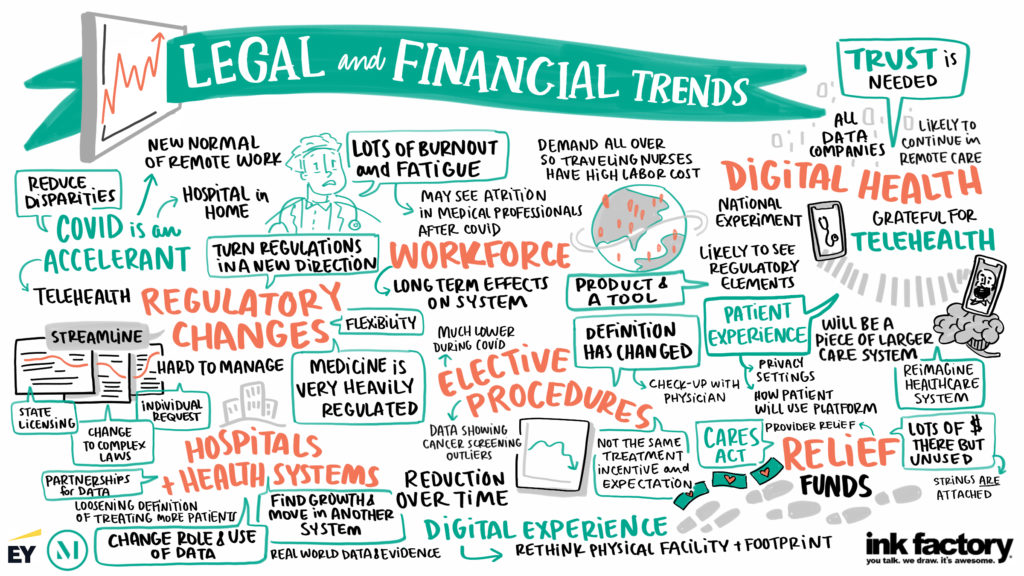Leading professionals Gary Burke (Partner, Forensics, EY), Sandy DiVarco, and Jennifer Geetter (Partners, McDermott Will & Emery), Mike J. India (Managing Director, EY-Parthenon) and Matthew Weiss, MD (EY-Parthenon Managing Director, Health care, Ernst & Young LLP) discussed critical legal, regulatory and financial trends facing hospitals and health systems with moderator, Charlie Buck (Partner, McDermott Will & Emery).
Below are the top takeaways for McDermott Will & Emery and EY during the 2021 J.P. Morgan Healthcare Conference: Hospital and Health System: Legal and Financial Trends, click here to access the full webinar.
Access the PDF here.
LONG TERM CHANGES TO REGULATORY RESTRICTIONS
Many regulatory requirements were relaxed in respond to the COVID-19 public health emergency. There has been much discussion regarding the extent to which these restrictions will “snap back” after the end of the public health emergency, because the public health emergency has highlighted the value of certain delivery models.
“I think there is going to be streamlining in some of these regulatory structures. So when we look at what’s going to be durable, hopefully we will see changes in the process that will make it easier for hospitals and other providers to respond and to remain on top of things,” said Sandy DiVarco, Partner, McDermott Will & Emery. “When the public health emergency expires, there’s a big concern that a number of these flexibilities and other regulatory waivers are going to go away, but as we’ve already seen in some areas like telehealth flexibilities and enhanced telehealth reimbursement, there are changes being made now to make some of these changes permanent, or at least for a longer period of time,” she continued.
HEALTHCARE WORKFORCE CHANGES
With many workers planning to retire or shift to other roles once the pandemic is over, turnover and attrition will be a problem within the industry. There will also be a need to help move skilled labor across state lines to fill gaps in the workforce.
“I think we’re going to see significant attrition in the healthcare workforce due to burnout from the pandemic on top of preexisting stress and dissatisfaction,” stated Matthew Weiss, MD, EY-Parthenon Managing Director, Health care, Ernst & Young LLP. “While liberalizing regulations around telehealth and practice across state lines may mitigate the impact, clinical labor costs will continue to rise at the same time as provider organizations try to improve their financial position in the face of the pandemic. In addition, we’ve learned a lot of lessons from the changes in patterns of care related to the pandemic that call into question the impact and necessity of certain services, which may decrease utilization long term.”
DIGITAL HEALTH AND TELEHEALTH AFTER EMERGENCE
The acceleration of telehealth will have broad ranging impacts. As the virtual experience improves, patients and consumers will demand similar convenience for their in-person visits. Digital health tools also need to be more integrated into care delivery. “When we talk about digital health, we want to pull back a little bit to frame what we mean and the different ways that these digital tools can be used,” said Jennifer Geetter, Partner, McDermott Will & Emery. “I would suggest that one thing we need to do is reimagine our whole delivery system. We will need a true digital strategy as opposed to something that’s used only occasionally or as a fancy add-on. So rather than having episodic digital encounters, we want to think about how we move this at the enterprise level, where we have a range of tools, a range of technologies and support beyond episodic care,” she continued.
THE FUTURE OF HOSPITAL HEALTH SYSTEMS IN RELATION TO STRATEGIC, DECISION-MAKING IMPERATIVE
Hospitals and health systems are reevaluating their core competencies and considering what functions that can outsource or place, potentially, in joint ventures. Non-core business can also become of source of revenue if offerings are extended to other parties. “The strategy still largely remains the same for providers, which is centered around trying to reach more patients.” said Mike J. India, EY-Parthenon Managing Director, Health care, Ernst & Young LLP. “I think what’s interesting though, is that there’s growing comfort levels that we see with providers loosening their definition of what it actually means to reach more patients. Should their role be to treat the patient and/or be the channel or enabler for the patient to be treated? That’s a question that we see them wrestling with, and probably one that they’ll wrestle with more, as we think about reshaping the way care is increasingly delivered with digital tools.”
To catch up on all of the sessions at the McDermott Will & Emery and EY during the 2021 J.P. Morgan Healthcare Conference, please click here.







